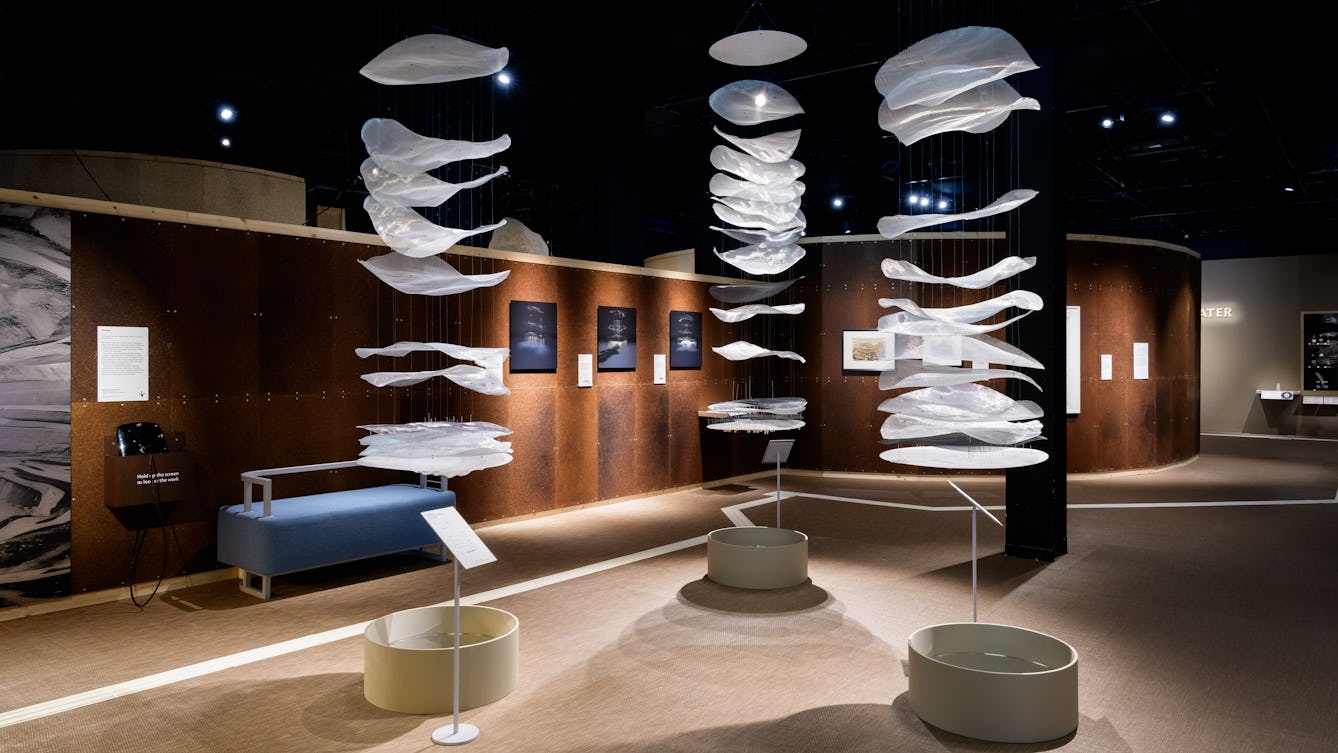When facing the QR code for this stop, the three sculptures described in this track are in the centre of the space behind you and to the left. There is also a bench along the wall to the left of the QR code. The bench is upholstered in a light blue fabric with a grey metal back. When sat on the bench, the sculpture will be directly in front of you.
Hi, my name is Anthony Acciavatti, a landscape and architectural researcher and the creator of the ‘Groundwater Earth’ project.
After ice, the majority of the Earth’s freshwater is stored underground. It is held in aquifers, porous rock and soil layers that can hold water, reaching as deep as 4.8 km. This water can be extracted using tube wells, mechanised technologies for drawing up groundwater, used in places where water supply is non-existent, unreliable, or polluted.
Originally a military invention from the 19th century, a tube well is usually composed of a perforated steel or plastic pipe that is bored between 1.5 and 300 metres below the ground to extract water from an aquifer. Global extraction of groundwater has reshaped military, urban and agricultural use of water.
In the centre of this space are three models – layered pillars made out of thin wire mesh and suspended by fine grey wires. Each one has a printed key, mounted on a stand next to it, showing what each of the layers represent.
The models serve as a visualisation of the long-term effects of water over-extraction in three sites: Jakarta in Indonesia, New Delhi in India, and the Phoenix-Tucson mega-region in USA.
They present Earth’s subsurface strata, the layers of rock or sediment found beneath the Earth's surface, and the impact of the tube wells on their respective water tables. These columns have been inverted, with the bottom-most layer above the base representing the built structures at ground level – the buildings replicated using upside-down wooden blocks on a translucent acrylic disc. There is also a mirror at the base of each pillar.
The first column you come to presents Jakarta. Here, groundwater over-extraction, paired with sea-level rise, has put the city in a perilous situation. Jakarta is now the fastest sinking city in the world, and saltwater is infiltrating freshwater reserves.
The next column on the left shows the New Delhi metropolitan region. Here there have been drastic changes in depth of the water table in the area. This makes underground water extraction a significantly more expensive endeavour along the western areas of the city where the water is now deep below the earth. In contrast, in the eastern edge, where the water table is much shallower, allows for access to this resource with less sophisticated pumping equipment.
The final column shows a view of the Phoenix-Tucson mega-region in the United States. In this area, there is a vast ancient aquifer beneath the urban sprawl. Thousands of tube wells, supporting agricultural uses and urban lifestyles, extract water faster than it can be replenished.
In all three regions, the depleted aquifers are causing major subsidence: the sinking of the earth due to the compacting of dry soil. This causes the gradual sinking of urban areas, the emergence of sinkholes and kilometre-long fissures across the Earth’s surface.
By accessing the crucial yet unregulated resource of groundwater, tube wells have empowered communities, circumventing unreliable water supplies. Hydrologists estimate that nearly half of the global population drinks groundwater daily and that over half of the world’s irrigated crops rely on it.
However, the same military invention that has allowed societies to thrive now threatens to bleed the Earth dry. This groundwater is rapidly depleting as we withdraw more and more for growing cities and agriculture. Between 1970 and 2000, global groundwater volume dropped by 30 per cent. In some regions in India, the US and China, levels fell by tens to hundreds of metres. The very tilt of planet Earth has shifted 80 centimetres between 1993 and 2010 as a result.
There is an invitation here to reflect on the delicate balance between technological advancement and environmental stewardship. While the examples in these models may seem local, tube wells tap into a vast, shared commons that rivals the air we breathe. It is imperative that we see groundwater differently as a collective, global challenge.
Thank you for listening. This is the end of stop 11 and this audio guide. If you return to the tactile line, it will lead you out of the gallery and into the museum atrium.
